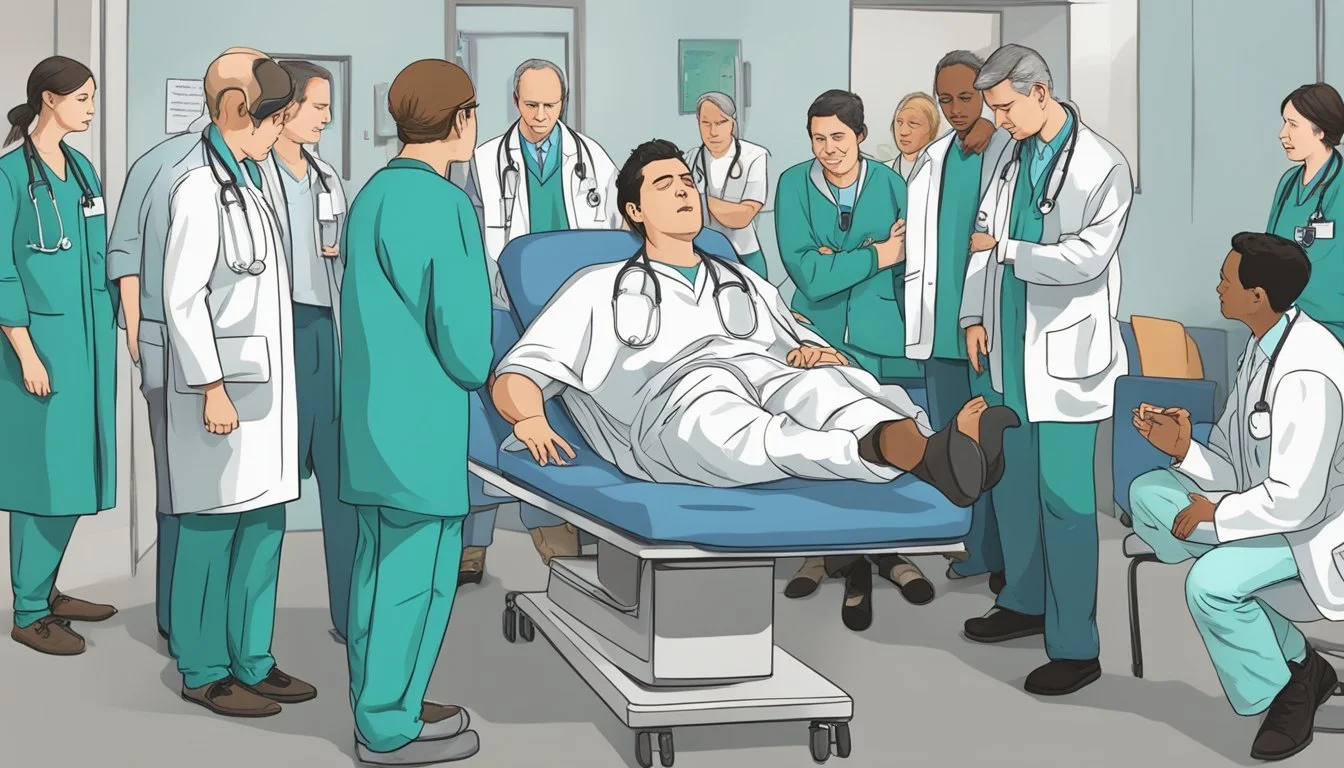Psychosis and Its Potential to Trigger PTSD
Psychosis and post-traumatic stress disorder (PTSD) are complex mental health conditions that can significantly impact an individual's life. While PTSD typically develops after experiencing or witnessing a traumatic event, psychosis involves a disconnection from reality. The relationship between these two conditions is intricate and multifaceted.
Research indicates that psychosis can indeed contribute to the development of PTSD in some cases. Studies have shown that up to 47 percent of individuals who experience psychosis may develop PTSD at some point. This connection highlights the potential for psychotic episodes to be traumatic experiences in themselves, leading to symptoms associated with PTSD.
The interplay between psychosis and PTSD underscores the importance of comprehensive mental health care. Individuals who have experienced psychosis may benefit from screening for PTSD symptoms, while those with PTSD should be monitored for potential psychotic features. Recognizing the potential link between these conditions can lead to more effective treatment strategies and improved outcomes for those affected.
Understanding Psychosis and PTSD
Psychosis and PTSD are complex mental health conditions that can significantly impact an individual's well-being. These disorders can occur independently or together, with potential interactions that affect diagnosis and treatment.
Exploration of Psychosis
Psychosis is a mental state characterized by a disconnection from reality. It typically involves hallucinations, delusions, and disorganized thinking. Hallucinations may include hearing voices or seeing things that aren't there. Delusions are false beliefs, such as paranoid thoughts or grandiose ideas.
Psychotic symptoms can vary in intensity and duration. Some individuals experience brief psychotic episodes, while others may have persistent symptoms. Causes of psychosis include mental disorders like schizophrenia, severe stress, substance abuse, and certain medical conditions.
Early intervention is crucial for managing psychosis effectively. Treatment often involves a combination of antipsychotic medications and psychotherapy.
Nature and Symptoms of PTSD
Post-Traumatic Stress Disorder (PTSD) is a mental health condition triggered by experiencing or witnessing a traumatic event. Common symptoms include intrusive memories, flashbacks, and nightmares related to the trauma. Individuals with PTSD may avoid situations or stimuli that remind them of the traumatic event.
Other PTSD symptoms include hypervigilance, irritability, and difficulty concentrating. Emotional numbness and feelings of detachment from others are also common. These symptoms can significantly disrupt daily life and relationships.
PTSD can develop immediately after trauma or months to years later. Risk factors include the severity of the trauma, lack of social support, and prior mental health issues.
The Intersection of Psychosis and PTSD
PTSD with secondary psychotic features (PTSD-SP) is a subtype where individuals experience both PTSD and psychotic symptoms. This condition can be challenging to diagnose and treat due to symptom overlap.
Psychotic symptoms in PTSD may include hallucinations or delusions related to the traumatic event. For example, a combat veteran might hear gunfire or see enemy soldiers that aren't present. These experiences can intensify PTSD symptoms and further impair functioning.
The relationship between PTSD and psychosis is complex. Severe stress from PTSD can potentially trigger psychotic symptoms in vulnerable individuals. Conversely, experiencing psychosis can be traumatic and lead to PTSD symptoms.
Treatment for comorbid PTSD and psychosis often requires a tailored approach combining trauma-focused therapy and antipsychotic medications.
Trauma and Its Effects on the Mind
Trauma can profoundly impact mental health, altering brain function and potentially leading to long-term psychological consequences. Exposure to traumatic events can reshape neural pathways and influence emotional regulation, memory processing, and stress responses.
Mechanics of Trauma Exposure
When a person experiences a traumatic event, the brain's stress response system is activated. This triggers the release of hormones like cortisol and adrenaline. These hormones prepare the body for "fight or flight" reactions.
In some cases, the brain may struggle to process the traumatic experience properly. This can lead to fragmented memories or difficulties integrating the event into one's life narrative.
Trauma exposure can also alter the functioning of key brain regions. The amygdala, responsible for processing emotions, may become hyperactive. Meanwhile, the hippocampus, involved in memory formation, can shrink in size.
Long-Term Consequences of Traumatic Experiences
Traumatic experiences can have lasting effects on mental health. Some individuals may develop post-traumatic stress disorder (PTSD), characterized by intrusive memories, avoidance behaviors, and hyperarousal.
Other potential long-term consequences include:
Anxiety disorders
Depression
Substance abuse
Dissociative disorders
Trauma can also impact cognitive functions like attention, concentration, and decision-making. Some individuals may experience changes in their sense of self or worldview.
Repeated trauma exposure can lead to complex PTSD, a more severe form of the disorder. This condition often involves difficulties with emotional regulation and interpersonal relationships.
Impact of Childhood Trauma
Childhood trauma can have particularly profound effects on mental health. The developing brain is especially vulnerable to the impacts of traumatic experiences.
Early life trauma may interfere with normal brain development. This can lead to alterations in stress response systems and emotional regulation abilities.
Children who experience trauma are at higher risk for developing:
Attachment issues
Behavioral problems
Learning difficulties
Mood disorders
The effects of childhood trauma can persist into adulthood. Adults with trauma histories often struggle with relationships, self-esteem, and emotion management.
Early interventions and supportive environments can help mitigate the long-term impacts of childhood trauma. Therapy and other mental health supports may be beneficial throughout life.
Clinical Presentation and Diagnosis
Accurate diagnosis of PTSD with psychotic features requires careful assessment of trauma history, PTSD symptoms, and psychotic experiences. Clinicians must differentiate between PTSD-related intrusions and true psychotic phenomena.
Identifying PTSD Symptoms
PTSD symptoms fall into four main clusters: intrusion, avoidance, negative alterations in cognition and mood, and alterations in arousal and reactivity. Intrusion symptoms may include flashbacks, nightmares, and intense psychological distress related to trauma reminders.
Avoidance involves efforts to avoid trauma-related thoughts, feelings, or external reminders. Negative alterations can manifest as persistent negative emotions, detachment from others, and inability to recall key aspects of the trauma.
Hyperarousal symptoms often present as irritable behavior, hypervigilance, exaggerated startle response, and sleep disturbances. Clinicians should assess frequency, intensity, and impact of symptoms on daily functioning.
Assessing Psychotic Disorders
Psychotic symptoms in PTSD may include hallucinations, delusions, and disorganized thinking. Auditory hallucinations are most common, often involving trauma-related content. Visual hallucinations or tactile sensations related to the traumatic event can also occur.
Paranoid delusions may develop, such as believing the world is unsafe or that others intend harm. Some individuals experience delusions of reference, interpreting neutral events as personally significant.
Disorganized thinking may manifest as tangential speech or difficulty maintaining goal-directed thoughts. Clinicians should evaluate the nature, content, and temporal relationship of psychotic symptoms to trauma exposure and PTSD onset.
Diagnostic Considerations for Psychosis in PTSD
Differentiating PTSD with secondary psychotic features from primary psychotic disorders is crucial. In PTSD-related psychosis, symptoms typically have trauma-related content and occur in the context of PTSD symptom exacerbation.
The DSM-5 does not include a specific diagnosis for PTSD with psychotic features. Clinicians may use the specifier "with psychotic symptoms" for PTSD diagnosis when appropriate.
Assessment should rule out other causes of psychosis, including schizophrenia, bipolar disorder, and substance-induced psychotic disorder. A thorough psychiatric history, including family history of mental illness, is essential.
Neurological examination and brain imaging may be necessary to exclude organic causes of psychosis. Careful consideration of symptom onset, course, and relationship to trauma is key for accurate diagnosis and treatment planning.
Treatment Approaches and Recovery
Effective treatment for psychosis-induced PTSD involves a combination of medical interventions, psychotherapy, and targeted rehabilitation strategies. These approaches aim to address both psychotic symptoms and trauma-related distress while promoting overall recovery and improved functioning.
Medical Interventions
Medication plays a crucial role in managing symptoms of psychosis and PTSD. Antipsychotics are typically prescribed to control hallucinations, delusions, and disorganized thinking. Second-generation antipsychotics like risperidone or olanzapine are often preferred due to their efficacy and reduced side effects.
For PTSD symptoms, antidepressants such as selective serotonin reuptake inhibitors (SSRIs) may be prescribed. These medications can help alleviate depression, anxiety, and intrusive thoughts associated with trauma.
In some cases, benzodiazepines might be used short-term to manage acute anxiety or sleep disturbances. However, their use is carefully monitored due to potential risks of dependence.
Psychotherapy and Support
Cognitive Behavioral Therapy (CBT) is a key psychotherapeutic approach for treating psychosis-induced PTSD. This therapy helps individuals identify and change negative thought patterns and behaviors related to their traumatic experiences and psychotic episodes.
Trauma-focused therapies, such as Prolonged Exposure (PE) and Eye Movement Desensitization and Reprocessing (EMDR), have shown promise in addressing PTSD symptoms in individuals with psychosis.
Group therapy and peer support groups can provide valuable emotional support and help reduce feelings of isolation. These settings allow individuals to share experiences and coping strategies with others facing similar challenges.
Strategies for Recovery and Rehabilitation
Recovery-oriented approaches focus on empowering individuals to lead fulfilling lives despite ongoing symptoms. This includes setting personal goals, developing coping skills, and rebuilding social connections.
Occupational therapy can help individuals regain independence in daily activities and return to work or education. This may involve practicing life skills, time management, and stress reduction techniques.
Family education and involvement are crucial for creating a supportive environment. Teaching family members about psychosis and PTSD can improve communication and reduce conflicts at home.
Lifestyle interventions, such as regular exercise, proper nutrition, and sleep hygiene, play a significant role in overall recovery and symptom management.
Psychobiological Aspects
The interplay between genetics and biology shapes mental health outcomes. Neurobiological mechanisms underlie psychotic symptoms, influencing how the brain processes information and responds to stress.
Role of Genetics in Mental Health
Genetic factors contribute significantly to mental health disorders. Studies show that individuals with a family history of psychosis or PTSD have a higher risk of developing these conditions. Specific gene variants associated with dopamine and serotonin regulation impact susceptibility to psychotic disorders.
Twin studies reveal a heritability estimate of 80% for schizophrenia. However, genetics alone do not determine outcomes. Environmental factors interact with genetic predispositions, influencing gene expression through epigenetic mechanisms.
Research identifies shared genetic risk factors between PTSD and psychotic disorders. This overlap suggests common biological pathways may underlie both conditions in some cases.
Biologic Underpinnings of Psychotic Symptoms
Neuroimaging studies show altered brain structure and function in individuals with psychosis. Key findings include reduced gray matter volume in the prefrontal cortex and hippocampus. These changes can affect cognitive processes and emotional regulation.
Neurotransmitter imbalances play a crucial role in psychotic symptoms. Dopamine dysregulation contributes to positive symptoms like hallucinations and delusions. Glutamate abnormalities relate to negative symptoms such as social withdrawal and lack of motivation.
Stress responses influence psychotic experiences. Heightened cortisol levels and HPA axis dysfunction are observed in both PTSD and psychosis. This biological stress sensitivity may increase vulnerability to traumatic experiences and psychotic episodes.
Impact on Daily Functioning and Mental Health
The combination of psychosis and PTSD can profoundly affect an individual's daily life and overall mental wellbeing. These conditions often impair cognitive abilities, emotional regulation, and social interactions.
Quality of Life with PTSD and Psychosis
Individuals experiencing both PTSD and psychosis often face significant challenges in maintaining a high quality of life. Their ability to engage in routine activities may be severely compromised. Simple tasks like grocery shopping or attending social gatherings can become overwhelming due to heightened anxiety and altered perceptions of reality.
Sleep disturbances are common, leading to fatigue and decreased daytime functioning. Intrusive thoughts and flashbacks associated with PTSD, combined with psychotic symptoms, can make relaxation and restful sleep elusive.
Emotional regulation becomes difficult, with individuals often experiencing intense mood swings. This emotional volatility can strain personal relationships and make it hard to maintain a stable home environment.
Challenges with Social Integration
PTSD and psychosis can create significant barriers to social integration. Symptoms like hypervigilance and paranoia may cause individuals to withdraw from social situations, leading to isolation.
Difficulty in trusting others is common, stemming from traumatic experiences and distorted perceptions of reality. This can result in strained relationships with family and friends.
Social stigma surrounding mental health conditions further complicates integration. Misunderstandings about PTSD and psychosis can lead to discrimination and exclusion in various social settings.
Support groups and therapy can help improve social skills and build a network of understanding individuals. However, consistent effort and professional guidance are often necessary to overcome these social challenges.
Effects on Professional Life
The impact of PTSD and psychosis on professional life can be substantial. Cognitive impairments associated with these conditions may affect concentration, memory, and decision-making skills crucial for job performance.
Maintaining regular employment can be challenging due to unpredictable symptom flare-ups. Absences and reduced productivity may lead to job instability or unemployment.
Workplace stress can exacerbate symptoms, creating a cycle of increased anxiety and decreased performance. This may result in difficulties advancing in one's career or securing long-term employment.
Specialized vocational programs and workplace accommodations can help individuals manage their symptoms while maintaining employment. However, disclosing mental health conditions to employers remains a complex decision for many.
The Societal Dimension
The societal impact of psychosis-induced PTSD extends beyond individual experiences. Public perceptions and healthcare systems play crucial roles in shaping outcomes for those affected.
Stigma and Misconceptions
Stigma surrounding psychiatric disorders often compounds the challenges faced by individuals with psychosis-induced PTSD. Many people misunderstand the relationship between psychosis and trauma, leading to harmful stereotypes. These misconceptions can deter individuals from seeking help.
Media portrayals frequently sensationalize psychotic episodes, reinforcing negative stereotypes. This can lead to social isolation and discrimination for those affected. Educating the public about the complex interplay between psychosis and PTSD is essential to combat stigma.
Employers may hesitate to hire individuals with a history of psychosis or PTSD, limiting opportunities for recovery and reintegration. Support groups and advocacy organizations work to challenge these attitudes and promote understanding.
Access to Mental Health Care
Availability of specialized mental health providers is crucial for treating psychosis-induced PTSD. Many regions face shortages of qualified professionals, leading to long wait times and inadequate care. Rural areas are particularly underserved.
Insurance coverage for mental health services often falls short, creating financial barriers to treatment. Some policies limit the number of therapy sessions or exclude certain interventions. This can result in incomplete or interrupted care for those with complex needs.
Integrated care models that address both psychosis and PTSD symptoms show promise. These approaches require coordination between different specialists and services. Telemedicine is expanding access in some areas, but technological barriers persist for some patients.
Early intervention programs can improve outcomes, but many healthcare systems lack resources to implement them effectively. Increasing awareness among primary care providers about psychosis-induced PTSD can help with timely referrals and treatment initiation.





